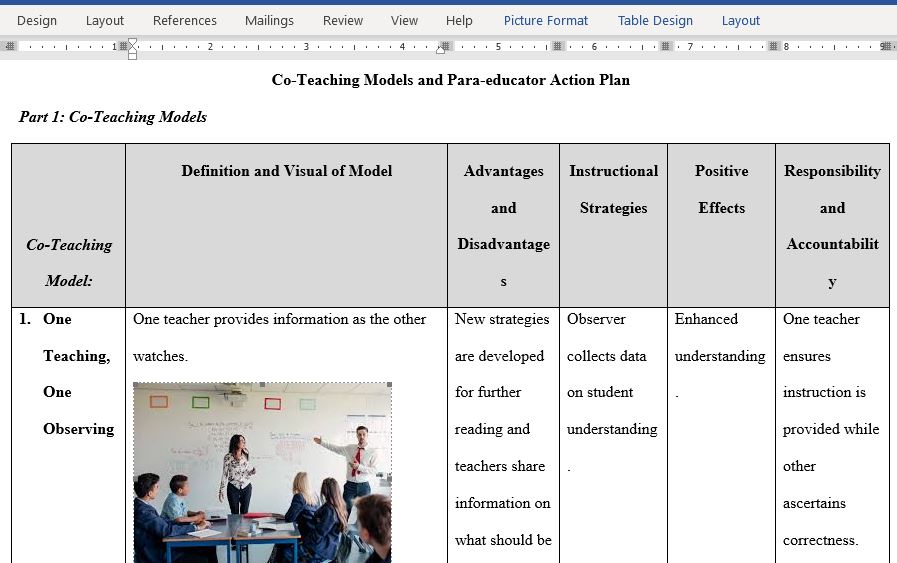Examine The Six Co-Teaching Models and How These Collaborative Models Can Provide a Better Learning Environment for All Students Especially Students with Disabilities
In this assignment, you will examine the six co-teaching models, and how these collaborative models can provide a better learning environment for all students, especially students with disabilities.
Part 1: Co-Teaching Models
Complete the “Co-Teaching Models and Paraeducator Action Plan” template that addresses the following:
- Co-Teaching Models: Define the six co-teaching models with a visual representation for each model (an appropriate link to the visual is acceptable).
- Advantages and Disadvantages: Discuss the advantages and disadvantages of each model.
- Instructional Strategies: Describe research-based instructional strategies unique to each model. Discuss how each supports individuals with disabilities.
- Positive Effects: Address the positive effects of each co-teaching model on teachers and students.
- Responsibility and Accountability: Explain how the shared responsibilities and accountabilities are executed when the co-teaching is between a general and special educator, and when the co-teaching includes collaborating with a paraeducator.
Part 2: Paraeducator Action Plan
Read the classroom scenario below, and complete Part 2 of the “Co-Teaching Models and Paraeducator Action Plan” template.
Ms. Jeter is a general education teacher in an inclusive seventh-grade classroom that will have 30 students including four students with learning disabilities (LD) and two students with emotional disabilities (ED). She was just informed that a paraeducator would assist her in the classroom for the new school year. She has spoken to the paraeducator and it appears that the two will work very well together in terms of compatible personalities and philosophies regarding students with disabilities. However, Ms. Jeter has never worked with a paraeducator before. Further, the paraeducator has never had this job before, but has worked as a Sunday school teacher and loves children.
The action plan should address the following:
- Teaching Philosophy and Vision of the Classroom Setting: Describe a philosophy and vision that incorporates the teacher/paraeducator relationship.
- Rules and Expectations: Describe 3-5 rules and expectations for the teacher and the paraeducator specific to student learning and behavior in the classroom.
- Collaboration Model Outline: Selected from Part 1 of this assignment, outline a collaboration model for the paraeducator that promotes the well-being of individuals with disabilities. Include possible challenges and advantages to utilizing the selected collaboration model.
- Roles and Responsibilities: Identify roles and responsibilities of the teacher and the paraeducator, including the discussion of confidentiality.
- Collaboration Time: Detail a plan for the teacher and paraeducator to meet regularly to prepare for units/lessons, reflect on teaching, review student achievement/goals, and provide feedback and mentoring to the paraeducator.
Answer Preview For Examine The Six Co-Teaching Models and How These Collaborative Models Can Provide a Better Learning Environment for All Students Especially Students with Disabilities
Access the full answer containing 1250 words by clicking the below purchase button

